Domain And Range Of 1/x
Domain and Range
Functions in mathematics tin exist compared to the operations of a vending (soda) machine. When you lot put in a sure amount of money, you can select different types of sodas. Similarly, for functions, we input different numbers and we get new numbers as the result. Domain and range are the primary aspects of functions. You tin can use quarters and one-dollar bills to purchase a soda. The automobile will not give you any flavor of the soda if pennies are input. Hence, the domain represents the inputs we tin can have hither, that is, quarters and 1-dollar bills. No matter what amount you pay, you won't get a cheeseburger from a soda machine. Thus, the range is the possible outputs we can accept here, that is, the flavors of soda in the machine. Let united states of america learn to find the domain and range of a given function, and besides graph them.
| 1. | What is Domain and Range? |
| two. | Domain and Range of a Function |
| 3. | Domain of a Function |
| iv. | Range of a Part |
| 5. | How To Calculate Domain And Range? |
| 6. | Domain and Range of Exponential Functions |
| seven. | Domain and Range of Trigonometric Functions |
| 8. | Domain and Range of an Absolute Value Office |
| 9. | Graphs of Domain and Range |
| 10. | FAQs on Domain and Range |
What is Domain and Range?
The domain and range are divers for a relation and they are the sets of all the 10-coordinates and all the y-coordinates of ordered pairs respectively. For case, if the relation is, R = {(1, ii), (2, 2), (3, 3), (four, three)}, then:
- Domain = the set of all x-coordinates = {1, two, 3, 4}
- Range = the set of all y-coordinates = {2, three}
We can visualize this hither:

Domain and Range of a Office
The domain and range of a function are the components of a function. The domain is the set of all the input values of a function and range is the possible output given past the office. Domain→ Function →Range. If there exists a role f: A →B such that every chemical element of A is mapped to elements in B, then A is the domain and B is the co-domain. The image of an element 'a' under a relation R is given by 'b', where (a,b) ∈ R. The range of the function is the set of images. The domain and range of a function is denoted in general as follows: Domain(f) = {ten ∈ R} and range(f)={f(x) : x ∈ domain(f)}
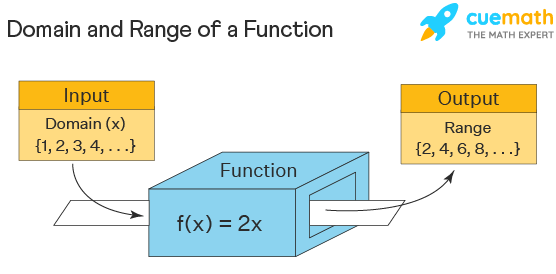
The domain and range of this function f(10) = 2x is given as domain D ={x ∈ N } , range R = {(y): y = 2x}
Domain of a Function
A domain of a function refers to "all the values" that go into a function. The domain of a function is the set of all possible inputs for the function. Consider this box equally a function f(x) = 2x . Inputting the values x = {1,2,3,iv,...}, the domain is simply the set of natural numbers and the output values are called the range. Just in general, f(10) = 2x is divers for all real values of x and hence its domain is the prepare of all real numbers which is denoted by (-∞, ∞). Here are the general formulas used to find the domain of different types of functions. Here, R is the set of all existent numbers.
- Domain of whatever polynomial (linear, quadratic, cubic, etc) function is R.
- Domain of a foursquare root function √ten is ten≥0.
- Domain of an exponential role is R.
- Domain of logarithmic part is 10>0.
- To find the domain of a rational function y = f(x), gear up the denominator ≠ 0.
Range of a Function
The range of a role is the set of all its outputs. Example: Let us consider the function f: A→ B, where f(ten) = 2x and each of A and B = {set of natural numbers}. Hither we say A is the domain and B is the co-domain. Then the output of this function becomes the range. The range = {set of fifty-fifty natural numbers}. The elements of the domain are called pre-images and the elements of the co-domain which are mapped are chosen the images. Hither, the range of the function f is the gear up of all images of the elements of the domain (or) the set of all the outputs of the function. In the upcoming sections, we tin meet how to find the range of unlike types of functions. Here are the full general formulas used to notice the range of different types of functions. Notation that R is the fix of all real numbers here.
- Range of a linear function is R.
- Range of a quadratic office y = a(x-h)2 + thou is:
y≥k, if a>0 and
y≤k, if a<0 - Range of a square root function is y≥0.
- Range of an exponential function is y>0.
- Range of logarithmic function is R.
- To find the range of a rational function y = f(x), solve it for 10 and set the denominator ≠ 0.
How To Calculate Domain And Range?
Suppose 10 = {1, 2, 3, 4, 5}, f: X → Y, where R = {(x,y) : y = x+1}.
Domain = the input values. Thus Domain = X = {1, ii, iii, four, five}
Range = the output values of the function = {two, 3, 4, five, six}
and the co-domain = Y = {2, 3, 4, 5, 6}
Let's understand the domain and range of some special functions taking unlike types of functions into consideration.
Domain and Range of Exponential Functions
The function y = ax, a ≥ 0 is defined for all existent numbers. Hence, the domain of the exponential function is the entire real line. The exponential function ever results in a positive value. Thus, the range of the exponential office is of the grade y= |ax+b| is y ∈ R , {y > 0}. Domain = R, Range = (0, ∞)
Example: Await at the graph of this function f: 2x
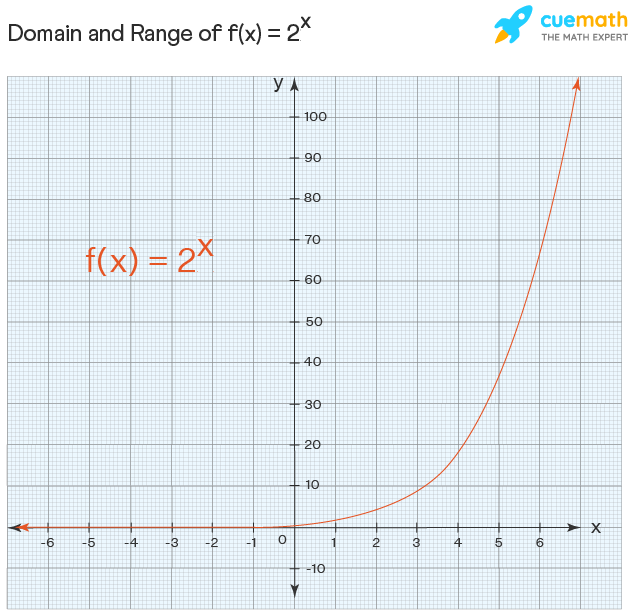
Observe that the value of the part is closer to 0 every bit x tends to ∞ but information technology will never attain the value 0. The domain and range of an exponential functions are given as follows:
- Domain: The domain of the function is the set R.
- Range: The exponential function e'er results in positive real values.
Domain and Range of Trigonometric Functions
Look at the graph of the sine function and cosine function. Notice that the value of the functions oscillates between -ane and 1 and it is defined for all real numbers.

Thus, for each of the sine and cosine functions:
- Domain: The domain of the functions is the set R.
- Range: The range of the functions is [-1, one]
The domain and range of all trigonometric functions are shown below:
| Trigonometric Functions | Domain | Range |
|---|---|---|
| Sinθ | (-∞, + ∞) | [-1, +1] |
| Cosθ | (-∞ +∞) | [-1, +1] |
| Tanθ | R - (2n + 1)π/2 | (-∞, +∞) |
| Cotθ | R - nπ | (-∞, +∞) |
| Secθ | R - (2n + 1)π/2 | (-∞, -1] U [+i, +∞) |
| Cosecθ | R - nπ | (-∞, -1] U [+1, +∞) |
Domain and Range of an Absolute Value Function
The function y=|ax+b| is defined for all real numbers. So, the domain of the absolute value function is the set of all real numbers. The absolute value of a number e'er results in a non-negative value. Thus, the range of an absolute value function of the form y= |ax+b| is y ∈ R | y ≥ 0. The domain and range of an absolute value function are given as follows
- Domain = R
- Range = [0, ∞)
Case: |six-x|
- Domain: The domain of the function is the fix R.
- Range: We already know that the absolute value function results in a non-negative value always. i.e., |half-dozen-x| ≥ 0, for all x.
Domain and Range of a Foursquare Root Function
The part y= √(ax+b) is defined only for x ≥ -b/a
Then, the domain of the foursquare root function is the set up of all real numbers greater than or equal to -b/a. We know that the foursquare root of something ever results in a non-negative value. Thus, the range of a square root function is the set of all non-negative real numbers. The domain and range of a square root part are given as: Domain = [-b/a,∞), Range = [0,∞)
Example: y= 2- √(-3x+ii)
Domain: A foursquare root part is defined only when the value within it is a non-negative number. Then for a domain,
-3x+2 ≥ 0
-3x ≥ -2
x ≤ ii/iii
Range: We already know that the square root function results in a non-negative value always.
√(-3x+2)≥ 0
Multiply -1 on both sides
-√(-3x+two) ≤ 0
Adding two on both sides
2-√(-3x+2)≤ 2
y≤ 2
Graphs of Domain and Range
Another style to identify the domain and range of functions is past using graphs. The domain refers to the gear up of possible input values. The domain of a graph consists of all the input values shown on the x-axis. The range is the fix of possible output values shown on the y-axis. The easiest method to find the range of function is by graphing it and looking for the y-values covered by the graph. To find the range of a quadratic function, it is sufficient to run into if it has a maximum or minimum value. The maximum/minimum value of a quadratic function is the y-coordinate of its vertex. To find the domain of the rational function, fix the denominator as 0 and solve for the variable. The domain is denoted by all the values from left to right along the x-axis and the range is given past the bridge of the graph from the top to the bottom.
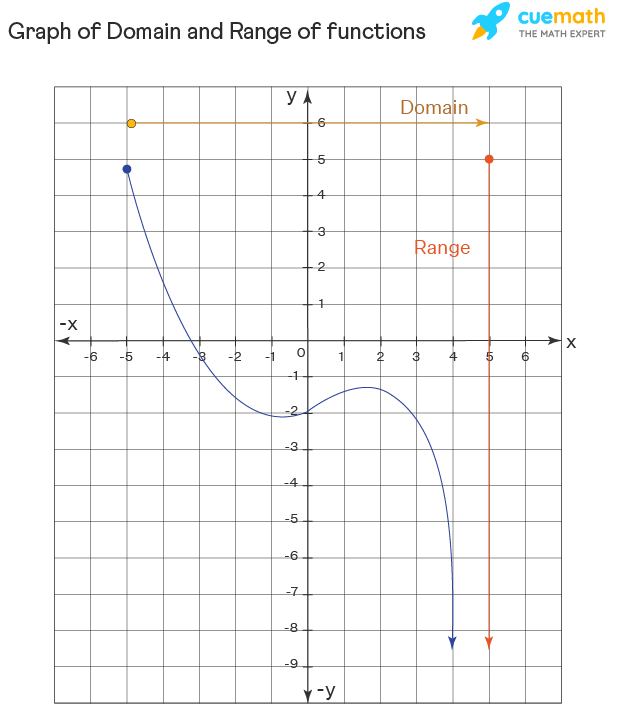
Domain and Range From Graph
It is very piece of cake to detect the domain and range of a function if its graph is given/known. The gear up of values of 10 covered past the graph gives the domain and the set of values of y covered past the graph gives the range. But keep a annotation of the following things while writing the domain and range from a graph.
- Run into whether the graph passes the vertical line test. Otherwise, it is not a function and we do not ordinarily define domain and range for such curves.
- If there is any hole on the graph, then its coordinates shouldn't exist in the domain and range.
- If in that location is a vertical asymptote, then the respective value of x shouldn't be at that place in the domain.
- If at that place is a horizontal asymptote, and then the respective value of x shouldn't exist there in the range.
- If the graph is broken into pieces, then nosotros get multiple sets/intervals in the domain and range and we club all such sets/intervals by "union" symbol (∪).
- If there is an pointer at the end of a curve, then information technology means that the curve is supposed to be extended infinitely in that particular direction.
Here is an case of a graph and nosotros volition find the domain and range from the graph.
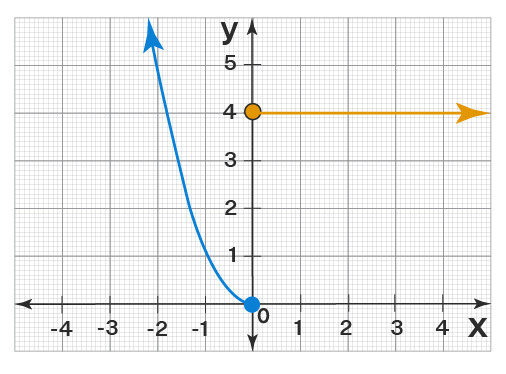
In the above graph:
- All the x-values from -∞ to ∞ are covered by the graph (because of arrows, the two curves extend infinitely in the given directions). Hence, the domain = (-∞, ∞).
- All the y-values greater than or equal than or equal to 0 are covered by the graph (run across there is no office of the curve that is below the y-axis). Hence, the range = [0, ∞).
Important Notes on Domain and Range:
- The domain and range of function is the prepare of all possible inputs and outputs of a role respectively.
- The domain and range of a function y = f(x) is given equally domain= {x ,x∈R }, range= {f(x), x∈Domain}.
- The domain and range of any function tin be found algebraically or graphically.
☛ Related Topics:
- Graphing Functions
- Cubic Functions
- Inverse Trigonometric Functions
Examples on Domain and Range
become to slidego to slidego to slide

Bully learning in high schoolhouse using elementary cues
Indulging in rote learning, yous are probable to forget concepts. With Cuemath, you will learn visually and be surprised by the outcomes.
Volume a Free Trial Grade
Practice Questions on Domain and Range
go to slidego to slide
FAQs on Domain and Range
What is the Domain and Range of a Function?
The domain and range of a function are the gear up of all the inputs and outputs a office can give respectively. The domain and range are important aspects of a function. The domain takes all the possible input values from the set of real numbers and the range takes all the output values of the office.
How Do Y'all Write the Domain and Range?
We write the domain and range of a function as the fix of all the inputs a function tin can take and the outputs of the functions respectively. The domain and range are written from the smaller values to the larger values. The domain is written from left to right and the range is written from the summit of the graph to the bottom.
What is The Natural Domain and Range of a Function?
The natural domain and range of a function are all the possible input values and the output values of the function respectively. Domain(f) = {ten∈R} and range(f)={f(x):x ∈ domain(f)}.
What is The Domain and Range of a Constant Function?
Let the constant function be f(10)=k. The domain of a constant function is given past R, that is, the set of real numbers. The range of a constant function is given by the singleton set, {m}. The domain and range of a constant function is given as domain = x∈R and range = {yard}, which is a singleton set.
How to Observe the Domain of a Role which is Rational?
To detect the domain of a rational function, nosotros simply set the denominator not equal to zero. For example, to notice the domain of f(x) = 2/(x-3), we set ten-3 ≠ 0, by solving this, we become x≠3. And so the domain is the set of all rational numbers except 3. This can be written in the interval notation as (-∞, 3) U (3, ∞).
How to Find the Range of a Rational Function?
To notice the range of a rational function, nosotros merely solve the equation for x and utilise set the denominator not equal to zero. For case, to discover the range of y=2/(ten-three), solve information technology for x first. Then we get, ten-3 = 2/y and from this, ten = (2/y) + three. Then its range is y≠0 (or) in interval annotation, (-∞, 0) U (0, ∞).
What are the Rules to Find the Domain of a Function?
Here are some general rules used to find domain of unlike types of functions:
- f(ten) = polynomial, the domain is the set of all real numbers.
- f(x) = one/10, domain if the set of all real numbers but x≠0.
- f(ten) = √x, domain if the set up of all existent numbers such that x ≥ 0.
- f(10) = ln x, domain is the set of all real numbers such that ten > 0.
How to Find The Domain and Range of Part Algebraically?
Let the function exist y=f(x). Let us find the domain and range of this office algebraically.
To calculate the domain of the part, we only solve the equation to determine the values of the contained variable x. To calculate the range of the part, nosotros simply express x equally x = g(y) and then find the domain of g(y).
How to Find The Domain and Range of an Equation?
To notice the domain and range, we simply solve the equation y = f(10) to determine the values of the independent variable 10 and obtain the domain. To calculate the range of the function, we simply express x as x=g(y) and then notice the domain of chiliad(y).
How to Calculate the Domain and Range From the Graph of a Part?
The ready of all x-coordinates of all points of the curve would give the domain and the set of all y-coordinates of all points of the curve would give the range. Each of the domain and range can be either written every bit a set or an interval.
What is The Difference Between Domain and Range of a Function?
Domain and Range of a function are the components of a role. The domain of a function is the set of all possible inputs for the office, whereas the range of function is the ready of all the outputs a office can requite.
What is The Domain and Range of a Relation?
the domain and range of a relation is found as follows. Let R be the relation from a non-empty set A to a non-empty set B. The domain and range of the relation are the set of start elements and the 2nd elements respectively in the ordered pairs in relation R is called the domain.
What is the Domain and Range of Composite Functions?
Allow the composite office be \(h=f \circ g\). The domain and range of h are adamant as follows. The domain of h is either aforementioned equally f or lies within the domain of f. The range h must lie within the range of g. Let f(x) = x2 and thousand(10) = x+ 3. We know that f: X →Y and g: Y →Z. And then fog: X →Z. f(1000(10)) = (x+iii)2. Thus the domain and range are: domain= {All the elements in set X}, range= {all the elements in prepare Z}
What is the Domain and Range of a Quadratic Function?
The domain and range of a quadratic role y=a(x-h)2+thousand determine the nature of the parabola: whether it is upwards or down or facing to the left or to the right.
- y ≥ k, if the function has a minimum value, that is, when a>0(parabola opens up)
- y ≤ k, if the function has a maximum value, that is, when a<0(parabola opens down)
Domain And Range Of 1/x,
Source: https://www.cuemath.com/calculus/domain-and-range-of-a-function/
Posted by: scottworsoll.blogspot.com

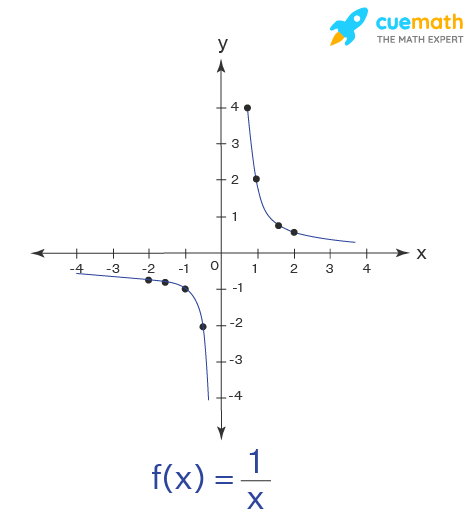

0 Response to "Domain And Range Of 1/x"
Post a Comment